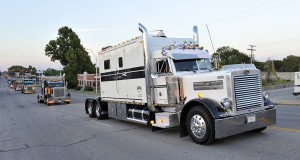 Back in 1975, C.W. McCall climbed to the top of the charts with his song about a renegade convoy of trucks. Starting small with just three trucks outside of Shakeytown (Los Angeles), they had grown to 85 by the time they hit Tulsa. This convoy then rolled up Interstate 44 like rocket sleds on rails, which led to the defiant truckers tearing up their “swindle sheets” (logs) just to “leave ‘em settin’ on the scales.” By the time they were laying a strip for the Jersey Shore, they didn’t have a doggone dime (and they weren’t a-gonna pay no toll), so they crashed the gate doing 98, let them truckers roll, ten-four! Boy does that bring back some memories.
Back in 1975, C.W. McCall climbed to the top of the charts with his song about a renegade convoy of trucks. Starting small with just three trucks outside of Shakeytown (Los Angeles), they had grown to 85 by the time they hit Tulsa. This convoy then rolled up Interstate 44 like rocket sleds on rails, which led to the defiant truckers tearing up their “swindle sheets” (logs) just to “leave ‘em settin’ on the scales.” By the time they were laying a strip for the Jersey Shore, they didn’t have a doggone dime (and they weren’t a-gonna pay no toll), so they crashed the gate doing 98, let them truckers roll, ten-four! Boy does that bring back some memories.
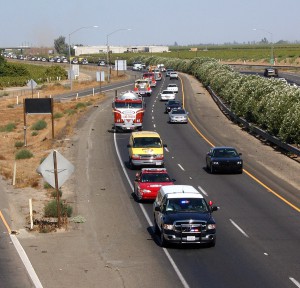 This old song represents a different time in trucking – a time filled with truck shut-downs, demonstrations and convoys of trucks defying the law. Flash forward to today and we still have the same issues C.W. McCall wrote about back then, but today’s convoys are an entirely different animal. Now, truckers and law enforcement come together at convoys to raise money for worthy causes, such as Special Olympics and various cancer treatment and prevention organizations. Back in September, I was lucky to have been able to participate in two convoys for Special Olympics, and they were awesome.
This old song represents a different time in trucking – a time filled with truck shut-downs, demonstrations and convoys of trucks defying the law. Flash forward to today and we still have the same issues C.W. McCall wrote about back then, but today’s convoys are an entirely different animal. Now, truckers and law enforcement come together at convoys to raise money for worthy causes, such as Special Olympics and various cancer treatment and prevention organizations. Back in September, I was lucky to have been able to participate in two convoys for Special Olympics, and they were awesome.
Norm Schneiderhan, a corporal with the Orange County Sheriff’s Department in Florida, was inspired by the powerful impact that the Special Olympics had on his life through his participation in the Law Enforcement Torch Run. That inspiration, combined with his family’s involvement with the trucking industry, caused him to create the first World’s Largest Truck Convoy for Special Olympics in 2001. After that first convoy, the idea took hold and spread – in 2014, there were convoys in 22 states and four Canadian provinces. Every year, thousands of trucks participate and hundreds of thousands of dollars are raised to help the athletes.
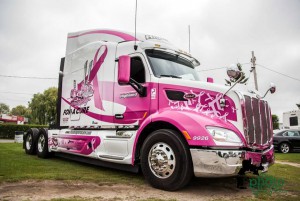 Founded in 1968 by Eunice Kennedy Shriver, Special Olympics has grown from a few hundred to more than four million athletes in over 170 countries. Funds raised at events like the Law Enforcement Torch Run and the convoys help to provide athletes the opportunities to develop physical fitness, realize their potential, experience joy at their accomplishments, demonstrate courage and share friendships with their fellow athletes and their families.
Founded in 1968 by Eunice Kennedy Shriver, Special Olympics has grown from a few hundred to more than four million athletes in over 170 countries. Funds raised at events like the Law Enforcement Torch Run and the convoys help to provide athletes the opportunities to develop physical fitness, realize their potential, experience joy at their accomplishments, demonstrate courage and share friendships with their fellow athletes and their families.
The convoy is one-day celebration that gives the trucking industry an opportunity to raise funds and awareness for Special Olympics, and better the image of the entire industry with the general public. There is a standard format that the convoys follow – trucks are staged at one location, then they follow a predetermined route escorted by law enforcement which block off intersections and ramps along the way, until all the trucks get to the convoy’s destination, where there is usually a celebration of some kind that brings the athletes and truckers together. Typically, the route is lined with waving people that cheer on all the trucks and hold “Thank You Truckers” or “Honk the Horn” signs.
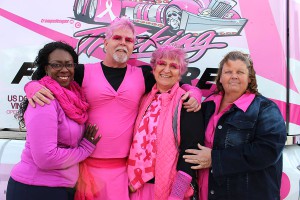 The athletes really love to get involved in the entire day – and why not – after all, this is all for them! Some ride in trucks while others eagerly wait at the destination with banners and big smiles welcoming the truckers. Once at the convoy’s final destination, the party begins. There is usually a picnic or barbecue, activities, and awards are handed-out to recognize some of the participants and sponsors. For a driver to participate, it typically costs $100, and they get a “goody bag” with a t-shirt and gifts from sponsors. The entry fee is tax deductible. At the beginning of the convoy, before it starts, the top spots to lead the parade are auctioned off to the highest bidders – and this is where much of the big money is raised for the cause.
The athletes really love to get involved in the entire day – and why not – after all, this is all for them! Some ride in trucks while others eagerly wait at the destination with banners and big smiles welcoming the truckers. Once at the convoy’s final destination, the party begins. There is usually a picnic or barbecue, activities, and awards are handed-out to recognize some of the participants and sponsors. For a driver to participate, it typically costs $100, and they get a “goody bag” with a t-shirt and gifts from sponsors. The entry fee is tax deductible. At the beginning of the convoy, before it starts, the top spots to lead the parade are auctioned off to the highest bidders – and this is where much of the big money is raised for the cause.
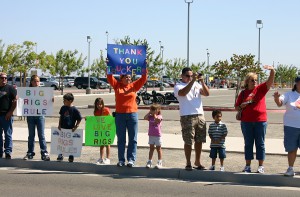 The first convoy I was involved in was in Wisconsin on September 20th. We were staged at the Pioneer Travel Plaza in Richfield, and then we traveled up Hwy. 41 some 53 miles north to the EAA (Experimental Aircraft Association) grounds in Oshkosh. I was honored to have three riders with me in that convoy – Butch and his sisters, Mary and Shirley, who drove all the way from Grand Rapids, MI to surprise Butch and fulfill his dream of riding in a big truck. Butch got the passenger seat while his sisters sat in the bunk. At the end of the ride, Mary hugged me and said, “It was perfect.”
The first convoy I was involved in was in Wisconsin on September 20th. We were staged at the Pioneer Travel Plaza in Richfield, and then we traveled up Hwy. 41 some 53 miles north to the EAA (Experimental Aircraft Association) grounds in Oshkosh. I was honored to have three riders with me in that convoy – Butch and his sisters, Mary and Shirley, who drove all the way from Grand Rapids, MI to surprise Butch and fulfill his dream of riding in a big truck. Butch got the passenger seat while his sisters sat in the bunk. At the end of the ride, Mary hugged me and said, “It was perfect.”
That convoy in Wisconsin featured 165 trucks and raised an astounding $122,000 for Special Olympics. Along the entire 53-mile journey, people were on almost every overpass, waving and cheering as we went by (some people even stood out in the fields along the highway to see the parade of trucks roll by). These events couldn’t happen without trucks AND sponsors. In Wisconsin, the “Presenting Partners” were Quad Graphics (who have been sponsoring this event since the first convoy in 2004) and E.H. Wolf & Sons. “Founding Partners” included the Wisconsin Motor Carriers Association and the Waupun Truck-N-Show, along with many others.
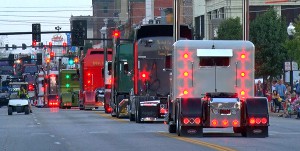 The second convoy I participated in was in Joplin, MO the next weekend, on September 27th. Again, I was honored to have riders, but this time it was Fernando and Abraham of Stay Loaded Apparel. I would call it “organized chaos” as hundreds of rigs rolled out of the 4 State Trucks lot and headed toward downtown Joplin. I was the last truck in line, with a police car behind me, signifying the end of the convoy, which I thought that was pretty cool. My company’s founder, Harry Quadracci, used to say, there are two trucks they will remember – the first one and the last one. I have to say, though, there were a lot of memorable trucks in-between, too!
The second convoy I participated in was in Joplin, MO the next weekend, on September 27th. Again, I was honored to have riders, but this time it was Fernando and Abraham of Stay Loaded Apparel. I would call it “organized chaos” as hundreds of rigs rolled out of the 4 State Trucks lot and headed toward downtown Joplin. I was the last truck in line, with a police car behind me, signifying the end of the convoy, which I thought that was pretty cool. My company’s founder, Harry Quadracci, used to say, there are two trucks they will remember – the first one and the last one. I have to say, though, there were a lot of memorable trucks in-between, too!
Last year, a convoy in Canada beat out the Joplin convoy for highest amount of trucks, but not by much. This year, Bryan Martin and his crew at 4 State Trucks, who were hosting their Guilty By Association Truck Show that weekend, were determined to be the biggest – and they were! With 300 trucks, they topped the Canadian convoy and raised over $76,000. The end of this convoy was in downtown Joplin, where all of the trucks parked along the historic streets (part of old Route 66) for a genuine “street party” and light show. The sponsors included Prime, Walmart, Kuhnle Bros., Peterbilt of Joplin, Fleenor Bros., TDC, Wallis Oil and M & M Wrecker.
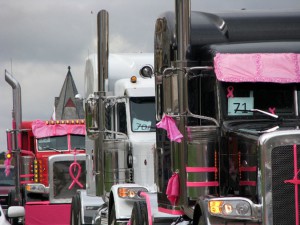 This last summer, on one trip when I was in Canada, I met Joanne Mackenzie – the founder of the “Trucking For a Cure” convoy. Her truck, with pink ribbons and an awesome truck decal on it, caught my eye right away. While we had dinner, she told me about her truck and the cause she is so passionate about. This organization, which is a Community Event Partner in support of the Canadian Breast Cancer Foundation, has raised over $300,000 for the Ontario region since it began in 2010. Their slogan, “Let’s Drive Out Breast Cancer 1 Truck at a Time!” is not only appropriate, but fun and catchy, too.
This last summer, on one trip when I was in Canada, I met Joanne Mackenzie – the founder of the “Trucking For a Cure” convoy. Her truck, with pink ribbons and an awesome truck decal on it, caught my eye right away. While we had dinner, she told me about her truck and the cause she is so passionate about. This organization, which is a Community Event Partner in support of the Canadian Breast Cancer Foundation, has raised over $300,000 for the Ontario region since it began in 2010. Their slogan, “Let’s Drive Out Breast Cancer 1 Truck at a Time!” is not only appropriate, but fun and catchy, too.
“The heart and soul of our event is our drivers each year,” said Joanne. “They all work together with their family, friends and co-workers to help turn the transportation industry pink in the month of October in support of breast cancer awareness.” Trucking For a Cure not only raises awareness and funds for the breast cancer foundation but also builds bridges between commercial drivers, the industry, the public at large, and, hopefully, unites trucking enthusiasts behind a meaningful cause. Their top “Pink Ribbon” sponsors include Cervus Equipment, Highland Transport, Meritor, and the TA Travel Center in Woodstock, Ontario – home of Trucking For a Cure since the beginning. This year the organization also hosted a second convoy in Prescott, Ontario, and it was a success, too.
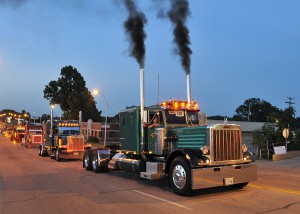 If you get a chance to participate in any of these (or other) convoys, be sure to take advantage of the opportunity. It’s a day of fun and it really feels good to be part of something so special. Many of the athletes look forward to this event and come back year after year, and you should, too. For all the bashing we get, it makes me proud to be a trucker and to see the drivers that come out and show the public what most truckers are really like – hard-working, good people with a crazy job to do that keeps our nation moving. And, most of them haven’t crashed any gates doin’ 98 in a long time!
If you get a chance to participate in any of these (or other) convoys, be sure to take advantage of the opportunity. It’s a day of fun and it really feels good to be part of something so special. Many of the athletes look forward to this event and come back year after year, and you should, too. For all the bashing we get, it makes me proud to be a trucker and to see the drivers that come out and show the public what most truckers are really like – hard-working, good people with a crazy job to do that keeps our nation moving. And, most of them haven’t crashed any gates doin’ 98 in a long time!
